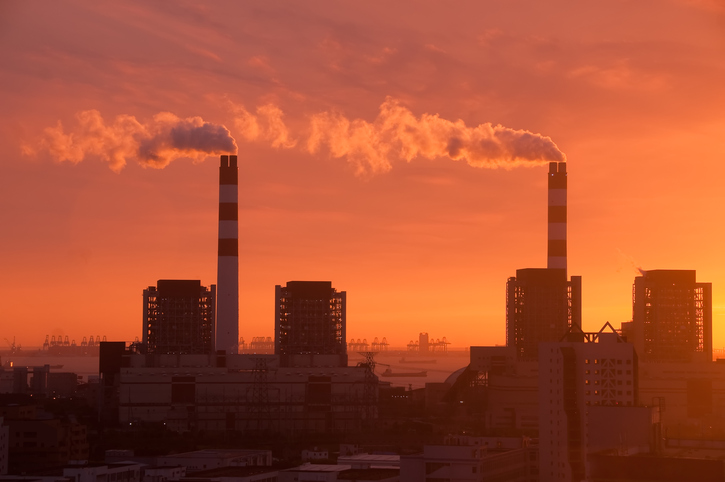
‘We haven’t got a hope in hell in net zero’ without focus on heat decarbonisation, says Naked Energy. Image: Getty.
Britain’s renewable energy sector has continued to boom in recent years, as the need to decarbonise electricity generation remains at the forefront of the country’s efforts to reach net zero. While it could arguably be seen as a success story however, other sectors have lagged behind, not least heat.
A report from the Department of Business, Energy and Industrial Strategy earlier this year suggested that “urgent changes” were required to reach home heat decarbonisation targets as government was off track.
There are a number of technologies expected to play a key role in this, including heat pumps and heat batteries, as well as solar thermal.
British solar thermal and solar PVT developer Naked Energy has been vocal on the need for more attention to be placed on the decarbonisation of the domestic heating sector.
The company’s VirtuPVT collector combines solar PV and solar thermal technology to generate both electricity and heat from a single collector. Additionally, its solar heat generation technology, the VirtuHOT collector, recently received TÜV international certification.
To find out more about the challenges associated with decarbonising heat, potential markets for solar thermal technologies and how to educate policymakers and investors, Solar Power Portal spoke with Christophe Williams, CEO and co-founder of Naked Energy.
What are some of the key focus points for Naked Energy and the solar thermal industry?
We’re trying to educate and raise awareness about the importance of decarbonising heat in the path to net zero. There’s been so much focus on electrification, the decarbonisation of power and electricity markets generally. But when you look at the global energy demand, where does the majority of energy go? It goes on heating and cooling buildings. The demand for heat is three times more than the demand for power and responsible for 40% of all global emissions.
51% of all global energy goes on heating and cooling – and 90% of that is driven by fossil fuels. Until we decarbonise heat, we haven't got a hope in hell of getting to net zero, let alone carbon net zero.
You have expressed the need to drive education in order for investors and policymakers to understand the urgency of heat decarbonisation. What measures do you think could be introduced to achieve this? Is enough currently being done?
Heat is the warm elephant in the room, and it’s gotten a lot bigger and a lot more expensive this year. The question now is what are we going to do about it?
Solar thermal is often overlooked in these conversations. Its potential is something we need to educate policymakers and investors on. I'm the chair of Solar Energy UK’s solar thermal working group, and right now we're working on a new solar heat report, due out later this year, that will serve as a tool to raise policymakers’ awareness of the value of solar heat.
More broadly, we must encourage policymakers and investors to take a technology agnostic approach because there's not just one solution that's going to solve our challenges – we need to look at low cost, carbon abatement solutions across the board. Reliable government funding for renewable infrastructure will dramatically increase investor and business confidence.
Naked Energy has set its sights on breaking into global markets, especially the US. How has this been progressing? What other global markets are currently under consideration?
The US is an important market for us strategically. The opportunity for solar thermal has dramatically increased with the recent passing of the Inflation Reduction Act, which is supporting local manufacturing and offering subsidies for property owners whilst incentivising on-site renewables. The US is interesting because historically energy has been very cheap – they’re quite self-sufficient in their energy generation. Yet with the stimulus of the Inflation Reduction Act, there’s now a big drive to decarbonise. It’s an exciting time to be entering the market.
Italy is another important country for us. They're reliant on 40% Russian gas, thus they’re dealing with very high energy prices right now. However, they've also got a lot of solar radiation. The heat and PV market is very mature in Italy, which is why we see it as a key market.
We’re also working to build our presence in Germany and the Netherlands. Germany is similar to Italy in having a very mature heat and PV market, while the Netherlands has a lot of government subsidies for on-site renewables – particularly solar heat. The Netherlands is currently developing several large-scale district heating projects. These are networks that distribute heat to an entire community – they’re particularly valuable in urban, high-density areas.
Similar to Austria and Denmark, the Netherlands has thermal arrays generating zero carbon heat in the summer, which is then stored in the ground in very large vessels, and used in combination with heat pumps to distribute heat in the winter when you need it.
We’re also gearing up to launch our Series B round to fund further global expansion. It’s a fascinating time for the business and we are looking for investors who share our green vision and align with our mission to decarbonise heat on a global scale.
